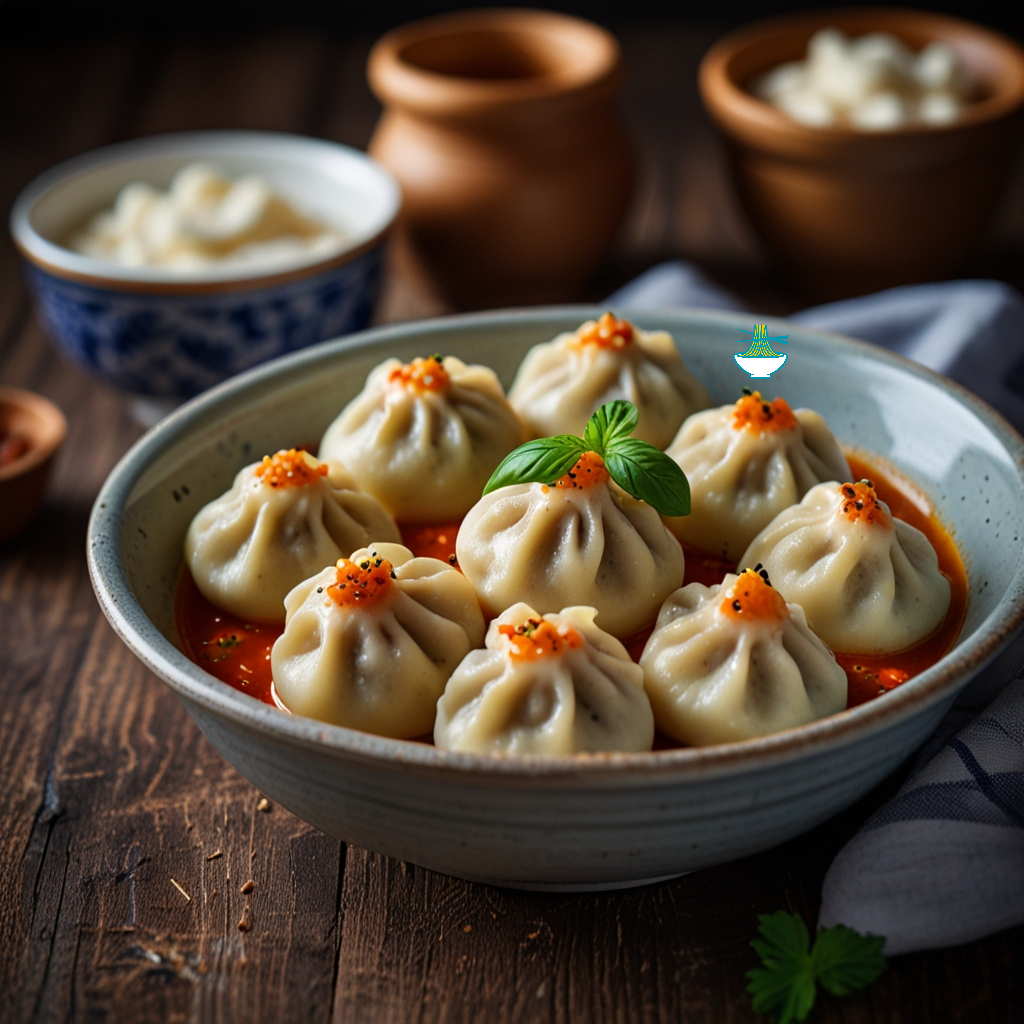Chuchvara, also known as chuchvarak or chakri, is a traditional Central Asian dish that originated in Uzbek cuisine. These small dumplings are similar in style to Russian pelmeni and Turkish manti but have their own distinct flavors and preparation methods.
The recipe typically involves making a simple dough from flour, water, and sometimes eggs. The dough is rolled out thinly and cut into small squares. The filling consists of minced meat, often lamb or beef, mixed with onions, garlic, and a blend of spices like cumin, coriander, and black pepper. The filling is then placed in the center of each dough square, folded, and sealed to create small dumplings.
Chuchvara is traditionally served boiled or steamed, then topped with a generous dollop of yogurt or sour cream. It's a popular dish for special occasions and family gatherings in Uzbekistan and other Central Asian countries, often enjoyed with a side of fresh herbs or a light salad.
The history of chuchvara dates back centuries, reflecting the rich culinary heritage of Central Asia. It has evolved over time, influenced by various cultural exchanges and regional preferences, but remains a beloved and iconic dish in the region's cuisine.
For clear and uncomplicated ingredients and preparation, you can follow this simple recipe for Chuchvara:
Ingredients:
- 1 pound minced meat (lamb or beef)
- 1 onion, finely chopped
- 2 cloves of garlic, minced
- 1 teaspoon ground cumin
- 1 teaspoon ground coriander
- Salt and black pepper to taste
- Wonton wrappers or homemade dough (flour and water)
- Yogurt or sour cream for serving
Method of Preparation:
1. In a bowl, mix the minced meat, chopped onion, minced garlic, ground cumin, ground coriander, salt, and black pepper until well combined.
2. Take a small portion of the meat mixture and place it in the center of each wonton wrapper or rolled-out dough square.
3. Fold the wrapper or dough over the filling to form a dumpling, sealing the edges tightly.
4. Bring a pot of water to a boil and add the dumplings. Cook until they float to the surface, indicating they are cooked through (about 3-4 minutes).
5. Remove the cooked chuchvara from the water using a slotted spoon and serve hot with yogurt or sour cream on top.
This straightforward recipe ensures a delicious and authentic chuchvara experience, perfect for enjoying this Central Asian delicacy at home.
Nutrition Value:
1. Minced Meat (Lamb or Beef)
- Calories: Approximately 250-300 calories per 4-ounce serving, depending on the fat content.
- Carbohydrates: Negligible, less than 1 gram per serving.
- Protein: About 20-25 grams per serving.
- Fat: Around 18-22 grams per serving, with variations based on the meat's leanness.
- Sodium: Typically minimal, unless seasoned heavily.
- Cholesterol: Approximately 60-80 milligrams per serving.
- Nutritional Benefits: Rich in protein, iron, zinc, and B vitamins. However, higher fat cuts can contribute to saturated fat intake.
2. Onion
- Calories: About 45 calories per medium-sized onion.
- Carbohydrates: Around 11 grams per onion.
- Protein: About 1 gram per onion.
- Fat: Very low, less than 1 gram per onion.
- Sodium: Minimal, naturally occurring.
- Cholesterol: None.
- Nutritional Benefits: Good source of fiber, vitamins C and B6, potassium, and antioxidants like quercetin.
3. Garlic
- Calories: Approximately 4 calories per clove.
- Carbohydrates: About 1 gram per clove.
- Protein: Negligible, less than 1 gram per clove.
- Fat: Very low, less than 1 gram per clove.
- Sodium: Minimal, naturally occurring.
- Cholesterol: None.
- Nutritional Benefits: Contains allicin, which has antibacterial and antifungal properties, plus vitamins C and B6, manganese, and antioxidants.
4. Ground Cumin
- Calories: About 8 calories per teaspoon.
- Carbohydrates: Around 1 gram per teaspoon.
- Protein: About 0.4 grams per teaspoon.
- Fat: Around 0.5 grams per teaspoon.
- Sodium: Minimal, depending on added salt content.
- Cholesterol: None.
- Nutritional Benefits: Contains iron, antioxidants, and may aid digestion and improve blood sugar control.
5. Ground Coriander
- Calories: Approximately 5 calories per teaspoon.
- Carbohydrates: About 1 gram per teaspoon.
- Protein: Negligible, less than 0.5 grams per teaspoon.
- Fat: Around 0.3 grams per teaspoon.
- Sodium: Minimal, depending on added salt content.
- Cholesterol: None.
- Nutritional Benefits: Contains antioxidants, vitamins A, C, and K, and may have antimicrobial properties.
6. Salt and Black Pepper
- Calories: Both are calorie-free.
- Carbohydrates: Negligible.
- Protein: None.
- Fat: None.
- Sodium: Varies based on usage; use sparingly for lower sodium content.
- Cholesterol: None.
- Nutritional Benefits: Salt provides sodium essential for fluid balance and nerve function. Black pepper contains antioxidants and may enhance nutrient absorption.
7. Wonton Wrappers or Homemade Dough (Flour and Water)
- Calories: Depends on the type and size of wrappers/dough.
- Carbohydrates: Varies but primarily from carbohydrates.
- Protein: Some protein content, especially in homemade dough with whole-grain flour.
- Fat: Minimal, unless enriched or made with fats like butter.
- Sodium: Varies, check packaging or recipe for details.
- Cholesterol: None in most cases.
- Nutritional Benefits: Wrappers or dough provide energy from carbohydrates and, if homemade, can offer fiber and nutrients from whole-grain flour.
8. Yogurt or Sour Cream
- Calories: Varies based on fat content and serving size.
- Carbohydrates: Varies, primarily from lactose (milk sugar).
- Protein: About 4-6 grams per ounce, depending on type.
- Fat: Depends on the type and fat content.
- Sodium: Varies, check labels for specifics.
- Cholesterol: Depends on fat content.
- Nutritional Benefits: Both provide calcium, probiotics (in yogurt), and protein. Opt for low-fat versions for reduced saturated fat intake.


Comments